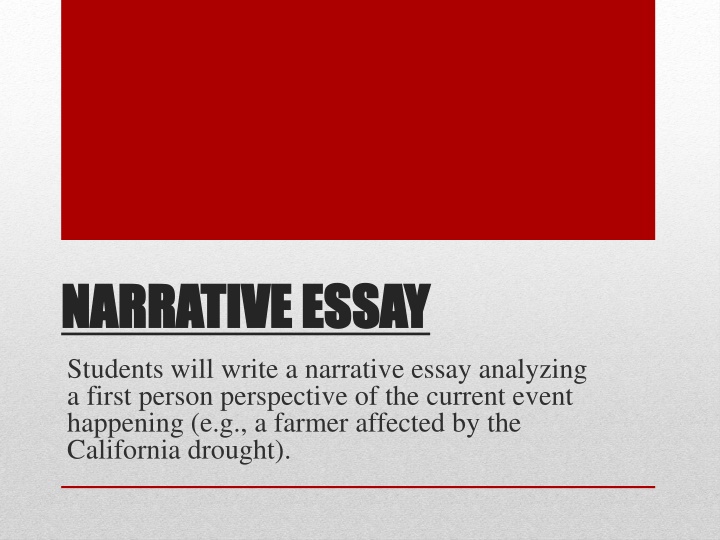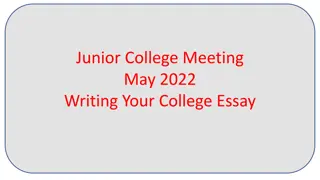Crafting a First-Person Perspective Narrative Essay
Explore the art of crafting a narrative essay from a first-person perspective, delving into the essence of storytelling through vivid details and character reflections on current events. Learn narrative techniques and guidelines for structuring compelling narratives, all through the lens of personal storytelling.
Download Presentation

Please find below an Image/Link to download the presentation.
The content on the website is provided AS IS for your information and personal use only. It may not be sold, licensed, or shared on other websites without obtaining consent from the author.If you encounter any issues during the download, it is possible that the publisher has removed the file from their server.
You are allowed to download the files provided on this website for personal or commercial use, subject to the condition that they are used lawfully. All files are the property of their respective owners.
The content on the website is provided AS IS for your information and personal use only. It may not be sold, licensed, or shared on other websites without obtaining consent from the author.
E N D
Presentation Transcript
NARRATIVE NARRATIVE ESSAY Students will write a narrative essay analyzing a first person perspective of the current event happening (e.g., a farmer affected by the California drought). ESSAY
Intro to Narrative PPT Section 2 of your notebook Narrative Techniques CN
You will write a narrative essay analyzing a first person perspective of your current event 1. Pretend that you are someone involved in your current event 2. Think of a situation related to your current event 3. Write a story from the perspective of that person in that situation 4. Include: Exposition, dialogue, logical sequence of events, vivid details, and a reflective conclusion Current Event Narrative
Relate events in a clear order. Use vivid details to re-create people, places, and events. Use first-person point of view in which you are the narrator (teller of the story). Suggest or explain the importance of the experience (This is called theme of your story). Develop a plot (a series of related events to develop a story) Include one or more characters, usually people or animals. Use dialogue (quoting the exact words of your characters). Have more than one paragraph Guidelines for a Narrative
Point of View - the vantage point from which a story is told In a narrative YOU are the narrator (adopting the character). The story is from your point of view. So you will use first person pronouns: I, me, my, mine, we, us, our, ours. NEVER, NEVER, NEVER use second person point of view (you, yours) to tell a personal narrative. (Exception: using quotation marks) You can use pronouns like she, he, it, him, them, but because your story is 1stperson, you cannot tell what other people in your story are thinking unless they tell you in the story!!! You can ONLY know what you, yourself think. Vocabulary for Narrative Writing
Tone This is your attitude toward the experience and audience. Form A narrative does not have a standard introduction with a thesis sentence, three body paragraphs, and a conclusion. It does, however follow chronological order a way of organizing events according to when they occurred, from the first action in an incident to the last. All Narratives must have a beginning, middle, and end! Vocab for Narrative Writing
Developing Your Narrative Beginning Introducing Setting This is the time and place where the story happens. The setting frames the action of your story. It should develop the mood (atmosphere) of your narrative. For example, a weathered, ragged, isolated house creates a mood of sadness. If it is relevant, tell what the weather is like. It also sets the mood. Perhaps the setting itself presents a problem. Sensory details can make the setting come alive. These include what you can see, hear, touch, taste, and smell.
Developing Your Narrative Beginning Introducing Characters Many stores start with a character, who performs the actions of the story; concentrate on one main character or possibly two. What are the main personality traits of the character? What does the character want and what obstacles does he/she face? You may describe the character: Directly Ex., he is nervous or She is determined. Through his/her words and actions Ex. you don t have to tell us a man is nervous if you show his pacing up and down or avoiding eye contact. His behavior proves it. You are revealing personality traits through his/her actions, behavior, and words. Through physical appearance - how the character looks, talks, and dresses Only include those details essential to the plot; for example, if the height and weight are not relevant, don t use them.
Developing Your Narrative Dialogue is important in developing a good narrative. Decide what kind of language your characters will use. Be careful that you do not fill your story with dialogue that is vague, empty, and meaningless. Use dialogue to make a story come to life. Do NOT overuse it. Be sure to punctuate your dialogue correctly and begin a new line for each change of speaker.
Developing Your Narrative Middle Conflict Develop the action with a problem or conflict. Center story on the conflict. Conflict is the heart of a narrative. Your main character might struggle with an internal conflict (such as a struggle within himself over some issue) or an external conflict (a struggle outside himself). Develop your main character here by showing his/her actions, thought, and words through the conflict. Remember not to try to develop too many characters.
Developing Your Narrative End/Conclusion: Theme Communicate the theme of your story here. It is the insight into human life that you as the narrator will convey through the story. It is also you conclusion.
Is your Narrative a STORY? Did you use dialogue to develop the events? Did you use pacing to develop the events chronologically? Did you use transition words, phrases, and clauses to connect ideas and events? (Avoid then, next, first, last, etc.) Did you use description to develop the events? Did you use precise words and phrases, relevant descriptive details, and sensory language Did you use reflection to develop the events? Does your story have a conclusion? Narrative Checklist
NEWS NEWS REPORT WRITING AND REPORT WRITING AND PRESENTATION PREP PRESENTATION PREP Students will write a news report after conducting research on a current event. They will look at the rubric for evaluating their Culminating Learning Experience presentations. They will use the rubric to practice their presentation skills with partners, and to objectively evaluate others presentations.
You will PRESENT your news report. To this end, you will write a 1 1 page SINGLE SPACED News Report that must last 5-6 minutes. Font type is Times New Roman, size 12, outline format, MLA Heading, single spaced MLA format! This accompanies your PowerPoint Presentation. Minimum of 5 slides and 5 pictures/visuals (1 per slide) Font size 30+ Bullet points, not complete sentences Use PPT as talking points for you and reminders for audience You MUST have a works cited page with your 5 sources (of 3 different varieties) You will compile all of your work into a packet News Report: Presenting!
You will PRESENT your news report. To this end, you will write a 1 1 page SINGLE SPACED News Report that must last 5-6 minutes. When submitting your final package on the day of your presentation, your materials must be stapled and collated in the following order (top to bottom): Rubric/Topic choices News Report Works Cited PowerPoint Handout Worksheets (Online Tips, Bias, 2 Article comparison) Be prepared for your classmates and teacher to ask questions at the end of your presentation (3 maximum) You may use NOTECARDS ONLY (you may NOT read from your paper) News Report: Presenting!
SIX-STEP GUIDE TO EFFECTIVE PRESENTATIONS ORGANIZATION GUIDE 1. Excite Step 2. Launch Step 3. Relate Step 4. Inform Step Main Points 5. Reiterate Step 6. Energize Step DELIVERY GUIDE 1. Use appropriate volume of speaking 2. Use variety in volume, rate, and pitch 3. Use appropriate pronunciation and articulation 4. Use appropriate eye contact 5. Use appropriate facial expressions, gestures, posture, and movements 6. Use minimal vocalized pauses (um, uh) or distracting mannerisms Presentation Prep CN
1. Excite Step (gain the audiences attention by introducing the topic in an interesting manner) Use a story, quote, joke, example, fact, statistic, question, demonstration, or presentational aid that introduces the topic in a clear and interesting way (here is what I am going to talk about) and gives the audience a purpose for listening (here is why my topic is important to you). Organization Guide
2. Launch Step (tell the audience what they are about to hear) State the specific purpose of the speech. If appropriate, define terms, orient the audience to the topic by providing essential background information, allay any fears or reservations the audience may have about listening to information on this topic, and/or establish your credibility as an authority on this topic. Present a specific overview of the main points of the speech. If appropriate, tell your audience how you will be conducting a question and answer session and for how long; for example, Toward the end of my remarks, I will answer questions for five minutes, and then I will conclude my remarks. Organization Guide
3. Relate Step (give the audience a purpose for listening) Present logical and motivating information regarding how the audience can benefit from listening to information on this topic. Use a transition into (or just after) the explanation of benefits that focuses attention on the importance of the information. Use statements such as This information is important to you because . . . or For these reasons, you can benefit from reflecting upon these ideas. Organization Guide
4. Inform StepMain Points (inform about the topic and use transitions) Organize your main points in a logical manner. Use supporting materials such as stories, quotes, jokes, evidence (authority testimony, examples, facts, and statistics), audience participation, demonstrations, and presentational aids to present your ideas in a clear and interesting way. Use appropriate transitions between the steps of the six- step guide and between main points and subpoints. Organization Guide
5. Reiterate Step (tell the audience what they have heard) If you conduct a question and answer session, ask for questions after finishing the last main point and before beginning the reiterate step. Use a transition into the reiterate step that focuses on the fact that the speech is coming to an end and restate the specific purpose of the speech. Do not transition into the reiterate step by saying in conclusion, in closing, in summary, or to reiterate. This signals the audience to leave physically and mentally.Be subtler. Use a statement such as I discussed with you today. . . . Provide a clarifying summary of each of the main points of the speech. Restate your main points, but go a step further and restate a few important ideas or complex ideas (ideas that may have been more challenging to explain and/or understand) from each of your main points. Include the ideas that you most want your audience to remember. Do not include any new ideas in the summary. Organization Guide
6. Energize Step (bring the speech to a satisfying close for the audience) Use a story, quote, joke, example, fact, statistic, question, demonstration, or presentational aid that highlights the importance of the topic and how the audience can benefit from the ideas presented. You might refer back to the attention getting technique that you used in the excite step. End with a topic-related definite final statement that encapsulates the specific purpose of the speech and ensures that the audience perceives that you have finished the speech. If appropriate, add a statement that refers to the occasion or to the audience. For example, I enjoyed speaking with you today or I look forward to hearing the rest of your speeches. Organization Guide
1. Use appropriate volume of speaking: Be sure that your audience can hear you. Look to the audience for cues as to whether your volume of speaking is appropriate (either too loud or too soft). Be aware that your voice will sound louder to you than it will to the audience. You might ask an assistant to send you a signal if you cannot be heard easily. Delivery Guide
2. Use variety in volume, rate, and pitch: Develop an oral/conversational speaking style. You want to sound said not read, even when you choose to read from a manuscript. Your style should be much like normal professional conversation. Raise or lower the volume of your voice and vary your rate and pitch of speaking according to the thoughts and feelings that you are trying to communicate in an effort to clarify and create interest in them. Use pauses to separate words into meaningful thought units, to emphasize ideas. Unless you are asking a question, be sure pitch level drops at the end of words, phrases, or sentences. You will sound more confident in yourself and in your message. Delivery Guide
3. Use appropriate pronunciation and articulation: Use proper sound and accent. Be sure to research the proper pronunciation of words. Consult the diacritical marks in a dictionary. You will lose credibility fast if you mispronounce words. Enunciate your words clearly and distinctly. Delivery Guide
4. Use appropriate eye contact: Use as much eye contact as possible. Practice your speech using your outline, note cards, manuscript, and/or presentational aids. Whatever form your notes take, be sure that they truly serve as an effective aid to your memory. Look at individuals in the eyes for approximately three to five seconds at a time. Establish eye contact with the entire audience not just those sitting in the front and in the middle of the audience; that is, look at audience members who are sitting in the front far left and front far right. Delivery Guide
5. Use appropriate facial expressions, gestures, posture, and movements: Animated and enthusiastic physical behaviors usually engender a positive response they make a speech more interesting to listen to and easier to understand, and they help to release pent-up energy and to communicate that the speaker knows and cares about the topic. When not gesturing, let your hands fall naturally to your side, keep your arms waist level and let one hand rest naturally on the other hand, or let them rest on a table or podium that you might be using. Use a confident, poised, and natural posture. Keep both feet flat on the floor and shoulder length apart. Place equal weight on both feet. Be sure to square your shoulders to the audience. Move on transitions or to manipulate presentational aids. Avoid random movements, pacing, swaying, and turning your back to the audience. Delivery Guide
6. Use minimal vocalized pauses (um, uh) or distracting mannerisms: Using vocalized pauses is simply a bad habit. Record yourself on audio or videotape, and see if you use distracting vocalized pauses. Once you are aware of the problem, you will feel yourself about to use a vocalized pause. When you do, simply pause, think about what you are saying, and then continue presenting your thoughts. Avoid distracting mannerisms like playing with your hair, scratching your head or the back of your neck, pulling on your earlobe, jingling coins in your pocket, taking your hand(s) in and out of your pocket(s), taking your glasses on and off, tossing a pen in the air, overusing a particular gesture, or perpetual motion. Delivery Guide
Using the guidelines and tips for effective organization, write your rough draft of your News Report: 1. Excite Step 2. Launch Step 3. Relate Step 4. Inform Step Main Points 5. Reiterate Step 6. Energize Step News Report Rough Draft
Use the rubric to evaluate: Peers Videos My Speech Speech Assessment
1. What did you like about the unit and would want to do again? What would you have changed about this unit or how would you improve this unit if we had to do it over again? What is the most memorable or interesting thing you have learned this unit? What advice would you give to a freshman next year? 2. 3. 4. Unit 3 Reflection























